14 Wildflowers That Grow in Rhode Island (Identification Guide With Pictures)
-
- Last updated:
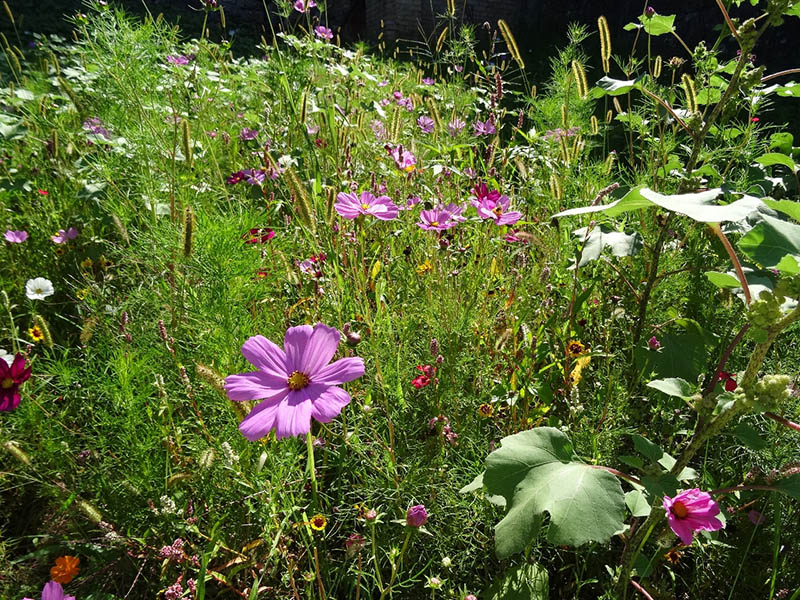
Rhode Island is one of the original U.S. colonies as well as the last to officially become a state. It may be one of the smallest states in the U.S., but it has so much to offer. The state features over 400 miles of shoreline, historical locations, monuments, and varied plant life. It also features forested areas that cover three out of every five acres in the state. This is perhaps why Rhode Island is home to over 1,200 native plant species that are native to the state.
In this article, we will highlight 14 of the most common wildflower species in Rhode Island. We also provide the growing information and pictures to help with the identification of the Rhode Island wildflowers. Read on to learn more.

The 14 Common Wildflowers in Rhode Island
1. Spotted Knapweed Wildflower, Centaurea stoebe

| Other names: | Panicled knapweed |
| USDA Hardiness Zone: | 3a–10b |
| Life Cycle: | Biennial |
| Approximate mature size: | 2–3′ (60–90cm) |
| Bloom Time: | Summer, fall |
| Sun Exposure: | Full sun |
The spotted knapweed is a type of wildflower that can be found growing in open fields and alongside roads throughout Rhode Island. Featuring a purple flower, this plant species is considered a weed in many places because it is an aggressive grower that can crowd out other plants.
It is an allopathic plant, meaning that it is capable of chemically changing the soil to discourage the growth of other plants in favor of its offspring. It may seem like a rude adaptation but this gives it an effective revolutionary advantage over other wildflowers in Rhode Island.
2. Creeping Charlie Wildflower , Glechoma hederacea
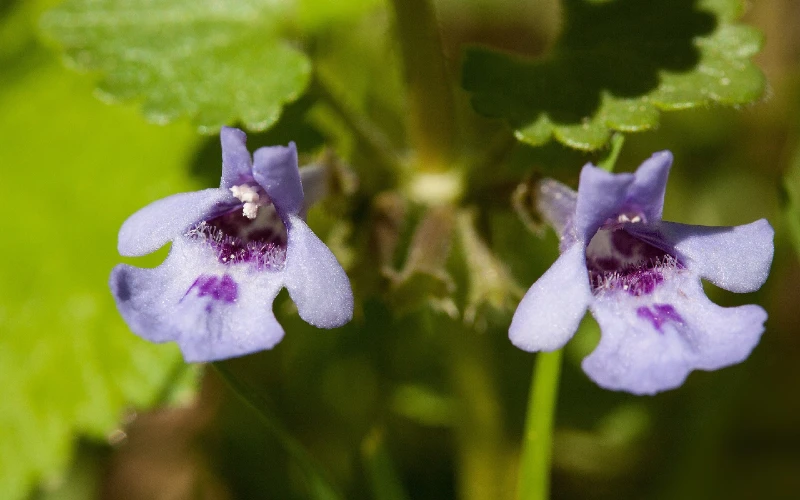
| Other names: | Ground ivy, tunhoof, hedgemaids, alehoof, run-away-robin, and catsfoot |
| USDA Hardiness Zone: | 3a–10b |
| Life Cycle: | Perennials |
| Approximate mature size: | 5–8″ (12.5–20 cm) |
| Bloom Time: | Spring, summer |
| Sun Exposure: | Sun to partial shade |
The Creeping Charlie is also a popular wildflower in Rhode Island and tends to grow in large clusters, especially in a moist and partially shaded area. This wildflower can also tolerate sun exposure very well. It supports insects like bees, which occasionally harvest pollen from the plant.
This flower is considered an invasive species in some areas. It is an aggressive grower in lawns and woodlands, mainly because it features an extensive root system, which makes it hard for one to weed it out by mowing or pulling by hand. So, be cautious not to allow this wildflower in your prized vegetable garden.
3. Purple Loosestrife Wildlfower, Lythrum salicaria
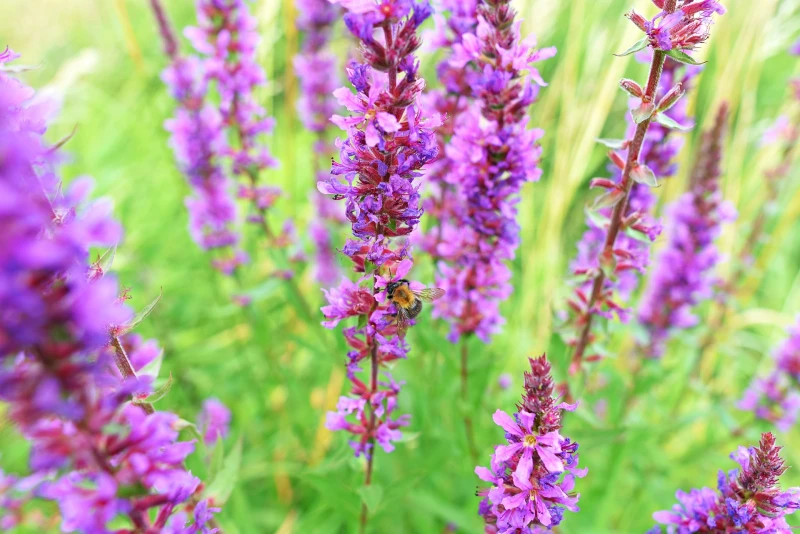
| Other names: | Purple lythrum and spiked loosestrife |
| USDA Hardiness Zone: | 3a–9b |
| Life Cycle: | Perennial |
| Approximate mature size: | 2–5′ (60–150 cm) |
| Bloom Time: | Summer |
| Sun Exposure: | Full sun |
The purple loosestrife wildflower can typically be seen growing in wet meadows, ditches, marshes, and along the lakes in Rhode Island. At first glance, it is hard to believe this perennial plant is an invasive species. However, it is considered a weed because it takes over and chokes out any surrounding native plant species.
This wildflower is known to produce very quickly because each of its flower spikes is capable of producing over 300,000 seeds. Furthermore, it quickly spreads through an area by growing new plant shoots from the extensive root system.
4. New England Aster Wildflower, Symphyotrichum novae-angliae

| Other names: | Michaelmas daisy, and hardy aster |
| USDA Hardiness Zone: | 3a–9b |
| Life Cycle: | Perennial |
| Approximate mature size: | 3–6′ (90–180 cm) |
| Bloom Time: | Fall |
| Sun Exposure: | Late summer, early fall |
The New England Aster is a type of wildflower that generally grows in moist environments in Rhode Island. However, it can survive and thrive in sand and dry soil.
This purple wildflower is a worthwhile perennial plant for a home garden because it can beautify your landscape with its long bloom time in autumn. Furthermore, if you let the seed heads dry up on the plant, you can harvest them and propagate them for future plantings.
5. Dames Rocket Wildflower, Hesperis matronalis
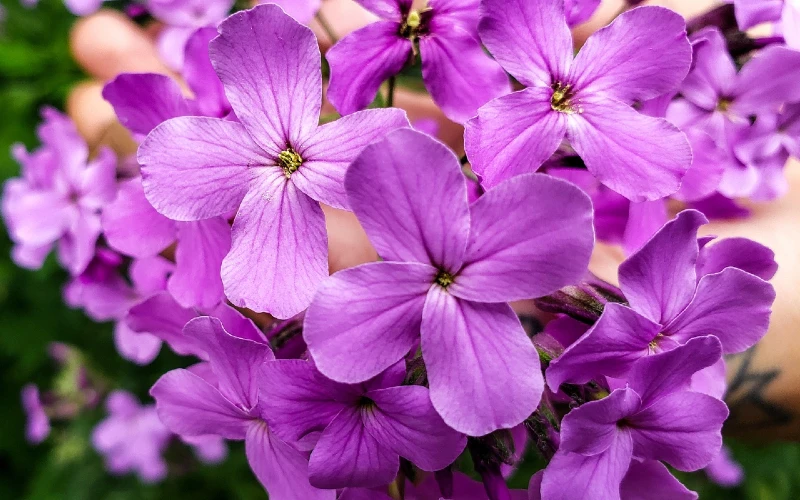
| Other names: |
Rogue’s gilliflower, summer lilac, night-scented gilliflower, queen’s gilliflower, sweet rocket, and mother-of-the-evening
|
| USDA Hardiness Zone: | 3–9 |
| Life Cycle: | Biennials or short-lived perennials |
| Approximate mature size: | 1–4′ (30–122 cm) |
| Bloom Time: | Early to mid-spring |
| Sun Exposure: | Full sun to partial shade |
Dame’s rocket is a purple wildflower that is typically spread throughout Rhode Island. It is a fast-spreading plant species, mostly found thriving in woodlands and meadows. If you are looking to purchase one for your garden, you can find it in prepackaged mixes labeled “wildflower seeds”
This plant species may be considered invasive in some areas; however, young leaves from the plant are rich in vitamin C. They provide ingredients for salads and have a slightly bitter flavor.
This spring-blooming wildflower is often confused with the native Phlox species because they feature similar large flower clusters. Nevertheless, you can tell the difference between them through their petal arrangements. Dame’s rocket has four petals per flower with alternately arranged leaves while the Phlox features five petals and opposite leaves.
6. Tall Morning Glory Wildflower, Ipomoea purpurea

| Other names: | Common morning glory and purple morning glory |
| USDA Hardiness Zone: | 2–11 |
| Life Cycle: | Annual |
| Approximate mature size: | 12–15′ (3.7–4.6 m) |
| Bloom Time: | Summer, fall |
| Sun Exposure: | Full sun, sun to partial shade |
The tall morning glory is a common species in Rhode Island. This perennial plant can be found growing in old fields, waste sites, gardens, and roadsides. It thrives best in dry and rich soil. However, this wildflower is considered a weed in some areas.
In the past, seeds from the flower have been used as a psychedelic. This is perhaps why its seeds that are retailing in the market are treated with methyl mercury. The toxic compound acts as a preservative as well as a poison to discourage the recreational use of tall morning glory seeds.
7. Canada Toadflax Wildflower, Nuttallanthus canadensis

| Other names: | Old-field toadflax and blue toadflax |
| USDA Hardiness Zone: | 4a–8a |
| Life Cycle: | Annual, biennial |
| Approximate mature size: | 8–10″ (20–45 cm) |
| Bloom Time: | Early spring, summer |
| Sun Exposure: | Full sun |
The Canada Toadflax is a common wildflower in Rhode Island and tends to bloom in large numbers in early spring. This makes it a critical source of nectar for butterflies and honeybees. Additionally, the leaves from the plant are also a food source for caterpillars.
Generally, the flower thrives in areas with full sun exposure, usually along grasslands and roadsides. However, be careful not to ingest any part of the plant, as it is poisonous.
8. Purple Coneflower Wildflower, Echinacea purpurea

| Other names: | Eastern purple coneflower, Eastern coneflower |
| USDA Hardiness Zone: | 2a–10b |
| Life Cycle: | Perennial |
| Approximate mature size: | 2–3′ (60–90 cm) |
| Bloom Time: | Summer, fall |
| Sun Exposure: | Full sun, sun to partial shade |
The purple coneflower is one of the hardest wildflowers growing in Rhode Island. This is perhaps because natives to the island love growing the plant in their home gardens. Furthermore, the flowers of the coneflower are resistant to heat and drought, allowing them to thrive in harsh environmental conditions.
This wildflower features a cone-shaped disc that consists of several small flowers rich in nectar. The colorful purple blooms from the plant usually attract hummingbirds, butterflies, and bees for sustenance, especially in summer and fall.
If you want to grow this species in your home garden, choose an appropriate space in your landscaping beds because it can grow up to four feet high. Furthermore, it grows in clusters and clumps measuring up to 2 feet wide. So, make sure you provide enough space for the plants to thrive.
9. Canada Thistle Wildflower, Cirsium arvense

| Other names: | Green thistle, hard thistle, and California thistle |
| USDA Hardiness Zone: | 3a–10b |
| Life Cycle: | Perennial |
| Approximate mature size: | 1–5′ (30–150 cm) |
| Bloom Time: | Late spring through early fall |
| Sun Exposure: | Full sun to partial shade |
As the name suggests, this wildflower is not native to Rhode Island, but it is considered one of the most invasive weeds in the state because it has a fast reproduction cycle, with each plant able to produce up to 5,300 seeds. It can be found growing in forests, wetlands, meadows, and grasslands.
If this species is growing near you, be careful not to touch the leaves. They are spiny and touching them will give you some level of discomfort.
10. Bittersweet Nightshade Wildflower, Solanum dulcamara
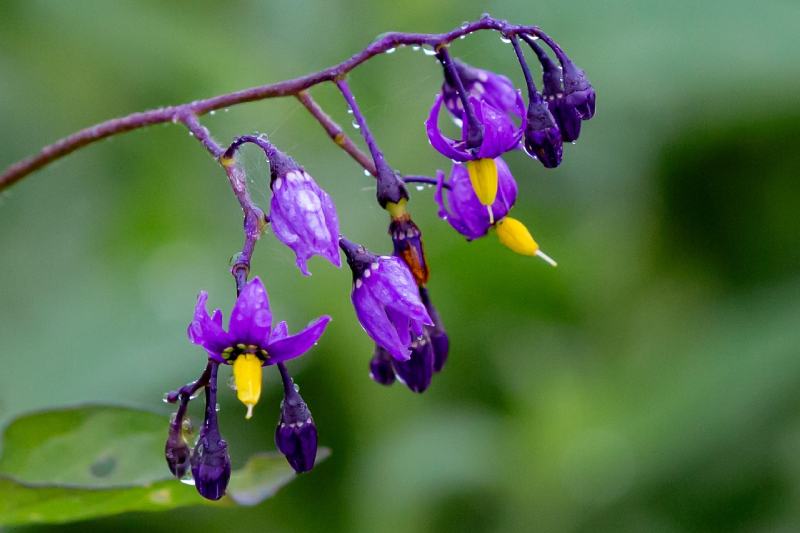
| Other names: |
Felonwood, poisonberry, trailing bittersweet, trailing nightshade, violet bloom, and poison flower
|
| USDA Hardiness Zone: | 4a–8b |
| Life Cycle: | Perennial |
| Approximate mature size: | 2–8′ (60–240 cm) |
| Bloom Time: | Spring, summer, fall |
| Sun Exposure: | Sun and light shade |
The bittersweet nightshade is a common species in Rhode Island. You can find it growing in hedges, scrublands, woodlands, and marshes. This wildflower species also produces small berries that are a source of nourishment for some birds.
However, just like other nightshade plant species, all parts of the bittersweet nightshade are poisonous to humans once ingested. Moreover, the foliage of the plant is toxic to animals too. Nevertheless, it features some beautiful blooms that appear in spring, summer, and fall.
11. Common Grape Hyacinth Wildflower, Muscari botryoides

| Other names: | Bluebells |
| USDA Hardiness Zone: | 3a–11b |
| Life Cycle: | Perennial |
| Approximate mature size: | 8–12″ (20–30 cm) |
| Bloom Time: | Spring |
| Sun Exposure: | Full sun, sun to partial shade |
This wildflower species closely resembles a cluster of small grapes, hence the name ‘grape hyacinth’. You can find it growing in different habitats including foothills, fields, plains, and alongside roads.
It usually blooms in spring to produce purple flowers that can make a lovely addition to a home garden. It is also easy to grow and has minimal maintenance practices. However, be on the lookout for squirrels, rabbits, and deer who enjoy munching on their fresh blooms.
12. Great Blue Lobelia Wildflower, Lobelia siphilitica
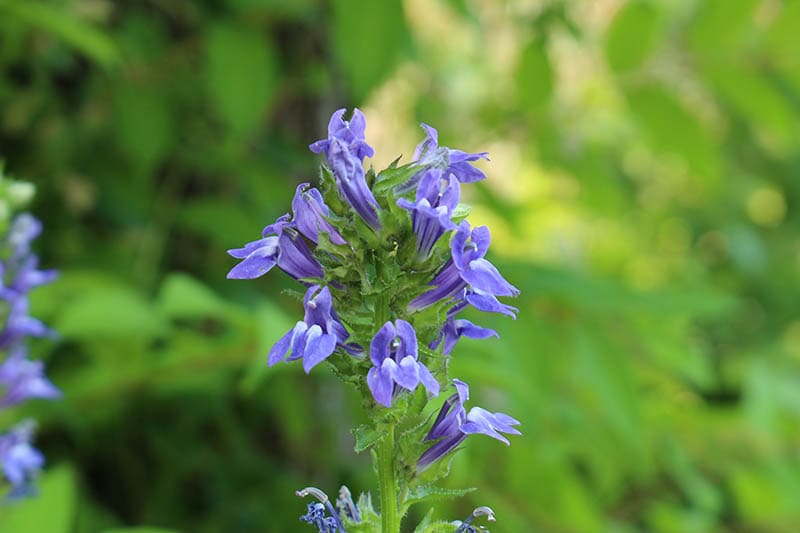
| Other names: | Blue cardinal flower and Great Lobelia |
| USDA Hardiness Zone: | 4a–9b |
| Life Cycle: | Perennial |
| Approximate mature size: | 1–4′ (30–120 cm) |
| Bloom Time: | Summer, fall |
| Sun Exposure: | Sun to partial shade, light shade |
The Great Blue Lobelia is also a wildflower that graces the Rhode Island landscape. This plant blooms to produce purple flowers that are very aesthetically pleasing. The plant typically thrives in moist soils and partially shaded environments. You can find it thriving in floodplains, roadside ditches, forest swamps, wet prairies, and lake margins.
Unlike other wildflowers, the Great Lobelia does not self-pollinate. The hummingbirds, butterflies, and bees attracted by its purple blooms pollinate it.
13. Showy Orchid Wildflower, Galearis spectabilis

| Other names: | Showy Orchid |
| USDA Hardiness Zone: | 4–7 |
| Life Cycle: | Perennial |
| Approximate mature size: | 5–12″ (12.5–30 cm) |
| Bloom Time: | Spring |
| Sun Exposure: | Partial shade, shade |
The showy orchid is also a common wildflower in Rhode Island, typically found growing on shady hillside areas. It can thrive in a rocky patch, a damp area, or even under a deciduous tree. The flower is rarely ever seen under the full glare of the sun.
This wildflower is beneficial to wildlife as it attracts many pollinators, such as bumblebees, moths, and butterflies, which feed on the nectar and help with the pollination process.
14. American Hog Peanut Wildflower, Amphicarpaea bracteata
| Other names: | Ground bean |
| USDA Hardiness Zone: | 5b |
| Life Cycle: | Annual, perennial |
| Approximate mature size: | 1–5′ (30–152 cm) |
| Bloom Time: | Summer, Fall |
| Sun Exposure: | Sun to partial shade, light shade |
The American Hog Peanut is one of the unique wildflowers growing in Rhode Island. It features two sets of flowers. The upper flowers are usually open and are pollinated by insects. The lower flowers are essentially underground vines that barely ever open, and they self-pollinate.
Another interesting aspect of the Hog Peanut is the fact that while both flowers produce seeds, the lower flowers are the only ones that produce a closed fruit called a Hog peanut. This is how the flower got its name. This plant can be found growing in forests, and it attracts different species of butterfly caterpillars, which munch on its foliage for sustenance.

Conclusion
For such a small area, Rhode Island features diverse landscapes, plants, and wildlife. From rocky shorelines with crashing waves, tangles of hemlock and rhododendron, salt marshes, dark pine forests, soggy bogs and swamps, and oak and beech forests, this state is truly magical.
You will definitely enjoy the diverse plant life that features thousands of native plant species. Among the most majestic are the wildflowers that are spread throughout the state. Most of these wildflowers grow naturally, without any human intervention. However, you can grow some in your home garden to beautify your landscape. Just make sure they are not poisonous and can thrive in your garden without choking other species.
Next on Your List:
- 15 Wildflowers That Grow in Iowa
- 10 Wildflowers That Grow in Mississippi
- 8 Wildflowers Native to Connecticut
Featured Image Credit: Jumpstory
Contents

